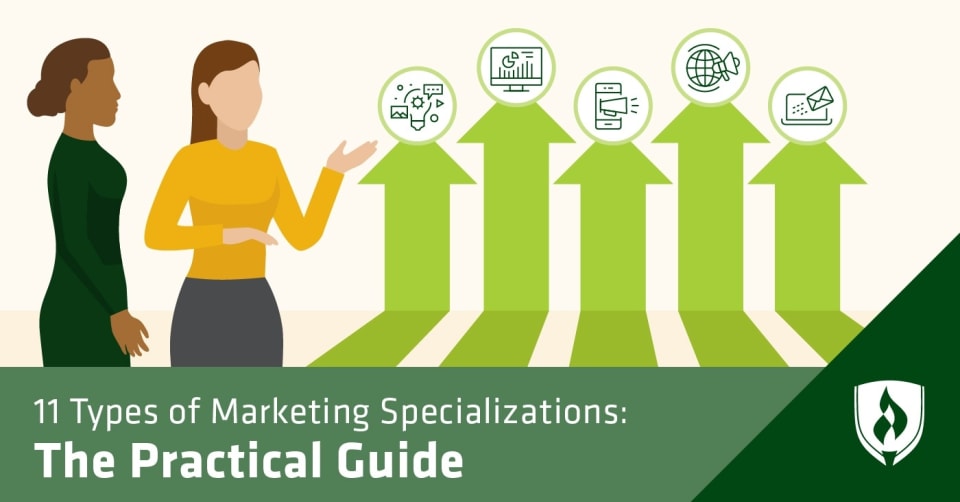
Marketing is marketing—it’s all basically the same selling tactics, dressed up in different forms, right?
While that has some truth to it, it drastically understates the complexity of the field. With so many avenues and approaches to “get the word out” these days, marketing has grown into an immense industry with loads of different niche areas. Nowadays, with digital marketing tactics becoming widespread, there are many types of marketing specializations to accommodate this dynamic profession.
But just because the field is complex, doesn’t mean you need to be stuck swimming in executive suite jargon or acronyms trying to make sense of it. We created this handy guide to help you cut through all of the terminology and help you gain a true understanding of these different types of marketing specializations.
11 Types of marketing specializations explained
Marketing is a complex field with a lot to master—the following types of marketing specializations cover everything from research to strategy to tactical execution. Keep reading to find an everyday explanation of eleven common specialties in the world of marketing.
1. Market research
What is market research? How do you know if a product, service or message will stand out to a particular audience? You do your research. Market researchers employ several tactics for picking the brains of the public and gathering information.
But that’s only one half of the equation. Another key component of market research is actually interpreting the data. The best market researchers are able to tailor their questions to encourage more meaningful answers. For example, asking, “What do you like about this product?” could yield a much different answer than, “As a parent, what do you like about this product?”
What does market research look like? Some of the most commonly used methods for gathering information include surveys, focus groups, qualitative interviews and even social media monitoring.
Where can I learn more? This guide from Qualtrics provides a fantastic primer on the basics of marketing research.
2. Content marketing
What is content marketing? Have you ever read a recipe on the side of a box of cereal? Did you notice how the ingredients always seem to include brand name products conveniently produced by the same company? That’s actually an example of early content marketing.
Content marketing is all about creating content—basically any consumable piece of information—that serves a purpose beyond just promoting a product. Think of it as advertising by offering something that is actually useful to the consumer. Content marketing can build positive sentiment for a brand by attaching the brand to something genuinely helpful or entertaining. When done successfully, consumers won’t even realize they are being marketed to—or they’ll at least tolerate it more than a pop-up ad or commercial.
What does content marketing look like? Content marketing can take the form of pretty much anything useful or entertaining. Common examples include recipes, blog articles, tutorial videos or travel guides.
Where can I learn more? The Beginner’s Guide to Content Marketing from Moz is a great starting point for anyone interested in learning more about this marketing specialization.
3. Search engine marketing (SEM)
What is search engine marketing? Some in the industry use SEM as a broad term encompassing both search engine optimization (SEO) efforts and paid search advertising activities. For the purpose of this article, we’re referring to the narrower definition that strictly refers to the paid search marketing side. This type of marketing is all about serving advertisements to people using search engines like Google® or Bing®. Search engine marketers bid to buy ad space on popular keyword terms related to the businesses they represent—for example, an appliance wholesaler buying ad space for the phrase “microwaves for sale.”
It may sound simple, but there is a lot of work that goes into optimizing a paid search campaign. Search engine marketers need to be analytical, strategic and willing to experiment and tinker with their campaign strategies to excel in this role.
What does search engine marketing look like? Time for an experiment—next time you fire up Google, try searching for “running shoes” (or nearly any item you’d purchase in a store, for that matter). Take a close look at the top handful of results. Notice anything? They’re likely all paid advertisements. That is the work of a search engine marketer.
Where can I learn more? Search Engine Land has all sorts of helpful resources for aspiring search engine marketers.
4. Video marketing
What is video marketing? Video marketing could be considered a subset of content marketing—but in all the forms that utilize film. Internet users consume a huge quantity of video content every day, and video marketers work to carve out a slice of that pie.
Many aspects of video marketing are similar to content marketing—defining goals, choosing platforms and target audiences and building a strategy. But video involves its own specific area of awareness and skills necessitating marketers who understand the strategy inside and out.
What does video marketing look like? Live videos around an event or a product release, behind-the-scenes video to build brand appreciation, educational videos—the list is long and spiraling. Impact Plus features several types of video marketing strategies—and the brands who are rocking each space for inspiring examples.
Where can I learn more? Look into Biteable’s Video Marketing Guide for a fairly comprehensive overview of how video marketing works and a step-by-step process for getting started.
5. Direct marketing
What is direct marketing? Simply put, direct marketing involves sending promotional marketing materials directly to consumers. As a consumer, you may not always appreciate these advertisements, but for years, direct marketing has been an effective way for businesses to increase the sales and general awareness of a business.
As you might imagine, it takes a lot of creativity to stand out from the clutter of other direct marketing materials sent to consumers on a regular basis. Creativity, however, will only take you so far. The solution for many direct marketers is to embrace personalization of marketing materials. This push for greater personalization leads to a blurring of the line between direct marketing and database marketing as businesses pursue multi-channel marketing strategies.
What does direct marketing look like? Check your mailbox. Odds are good that you’ve received some form of direct marketing in the mail. Common examples include coupons to your local pizza joint or a car dealership reminding you to schedule your next oil change.
Where can I learn more? Direct Marketing News has created several useful guides related to direct marketing.
6. Database marketing
What is database marketing? If the challenge of direct marketing is reaching consumers on a personal level, the answer can, at least partially, be found in database marketing. Thanks to the internet and the massive amount of consumer data collected from it, it is easier than ever for a marketer to create personalized, automated messaging for consumers.
By collecting information about consumer preferences, database marketers are able to send targeted messages to consumers at each step of the buying process. Their messages can essentially “follow” their audience throughout their normal online activity.
What does database marketing look like? Say you’ve had your eye on a new coat from your favorite online retailer. You add it to your virtual cart but after some deliberation, you decide you’ll pass on it for now. The next day you notice an ad for that exact coat pop up in your social media newsfeed. Then you check your email and, coincidentally, that exact coat is on sale! This is database marketing at its finest.
Where can I learn more? Neil Patel & Ritika Puri’s Definitive Guide to Marketing Automation provides a fantastic walkthrough of marketing automation and database marketing principles.
7. Social media marketing
What is social media marketing? The purpose of social media marketing is generally to drive traffic to a company’s website while boosting overall brand awareness and customer loyalty. Marketers achieve this by using a variety of methods on various social media platforms, from Facebook to Snapchat and everything in between.
Social media gives brands and businesses the opportunity to interact with the public in a personalized way. These interactions can play a huge role in the way a business is perceived, so it’s important for social media marketers to be very considerate of how their messaging could be interpreted. The potential for both massive success and total disaster is very real, so it’s important to tread carefully.
What does social media marketing look like? Examples of social media marketing are not hard to find. Just take a look at the social media accounts of business giants like Coca-Cola® or Target® to get an idea of how a sophisticated social media marketing presence operates.
Where can I learn more? Quicksprout’s Guide to Social Media Strategy is a great place to understand the fundamentals of this marketing specialty.
8. Influencer marketing
What is influencer marketing? Similar to social media marketing, influencer marketing relies on the consumer presence invested in various social media platforms—but instead of establishing a company account, marketers work with influencers to get the word out about their brand. This strategy can be exceptionally powerful because it relies on social proof and taps into the trust followers already have for the people they follow.
Influencer marketing is an especially prevalent strategy on Instagram and YouTube. There are many variables to consider, a few of which are choosing the right influencers for your company’s brand, developing brand messaging, working with the influencer and measuring value.
What does influencer marketing look like? Pretend you’re an avid knitter and see one of your favorite Instagram textile artists praising a specific brand of yarn in the new pattern they are creating. You go online to look it up and potentially purchase the yarn for your next project. Consider yourself influenced.
Where can I learn more? What Will Influencer Marketing Look Like in 2020 by Hubspot offers a great breakdown on how marketers use influencer marketing as well as how the landscape is changing year to year.
9. Guerilla marketing
What is guerilla marketing? No, marketing isn’t war. But there is something to be said for the effectiveness of the element of surprise. Guerilla marketing is all about using the unexpected to make a strong impression at public events or heavily trafficked areas.
This marketing technique isn’t particularly common, but that’s part of the appeal. The extraordinary nature of the tactics employed are what makes it effective and memorable.
What does guerilla marketing look like? This is essentially anything that makes a splash in public. Quintessential guerilla marketing tactics include promotional displays, graffiti, customized billboards or flash mobs.
Where can I learn more? These guerilla marketing guidelines from Marketo are a great starting point.
10. Event marketing
What is event marketing? Often associated with the term experiential marketing, this tactic requires significantly more time and investment than a social media post. But events can offer a huge bang for your marketing buck when done well. Counterintuitively, event marketing is becoming even more effective in the increasingly digital world. When computers and phones are brimming with ads and information, giving people a reason to gather face-to-face can stand out like a lighthouse in a storm.
What does event marketing look like? Pop-up shops, a sponsored 5K, trade shows, ceremonies, product release celebrations and networking events are all forms of event marketing. Since the event (and its potential ROI) depends so entirely on the company and its audience or clientele, a marketing event can take any form you can dream of. Look closer into effective event marketing examples to gather inspiration!
Where can I learn more? Aventri’s 2020 Event Marketing Guide offers a deep dive into the event marketing landscape as it stands today.
11. Product marketing
What is product marketing? Product marketing is the focus area devoted to strategically bringing a new product or service to market. We tend to take it for granted, but the everyday products you see on the shelf of a store have all likely had hours upon hours of strategic planning devoted to their price, presentation, competitive positioning and much more.
This discipline sets the strategy, guiding many of the marketing specializations featured above. Is the product considered luxury? A bargain? What features make it stand out? Do we need to educate people about what the product is or does? Product marketing specialists are responsible for answering those questions and plotting a course for individual marketing channels to execute.
What does product marketing look like? The work of this marketing specialization can take many forms and will depend on the organization, but much of their work is based on research. They’ll dig into the competitive landscape to understand the important variables related to competitors’ products, review and synthesize consumer research information and meet with product development teams to better understand the features of the product. This information is then used to formulate an overall product marketing strategy.
Where can I learn more? The WordStream Guide to Product Marketing gives a great crash course in product marketing and the factors that drive it.
What does specialization mean for marketers?
If you read up on the types of marketing jobs that align with these specializations, you might worry about getting locked into one focus area for your career. While it’s true that specializing can send you into the deep end of a marketing niche, remember that there’s plenty of crossover potential between these focus areas.
It’s also important to remember that many organizations lack the resources to employ multiple specialized marketing teams, creating plenty of demand for marketing professionals who work as generalists.
No matter the structure of the marketing organization or the scope of your role, understanding the basic idea of these marketing specializations can only help you. Who knows? You may eventually be in the position to develop a broad marketing strategy that encompasses every type of marketing specialization outlined above.
Build your marketing foundation
Now that you’ve had a brief introduction to the types of marketing specialization out there, it’s time to start learning the basics. Although they’re each unique in their own way, all eleven of these areas have deep roots in traditional marketing fundamentals.
So before you start mastering any specialized skills, start with the essentials. Learn how a Bachelor's degree in Marketing will help equip you with the foundational knowledge and training needed to succeed in any of these types of marketing.
Related Articles:
- Deciphering 7 Different Types of Marketing: Which One Is Right for You?
- 6 of the Best Business Jobs for Shy People Like You
- What Does a Sales Assistant Do? A Closer Look at This Entry-Level Sales Springboard
- A Better Picture of Entry-Level Business Management Jobs
- Inflated Job Titles: Helpful or Hot Air? What HR Pros Should Know
- 11 Essential Business Skills You Mastered Selling Girl Scout Cookies ... and Still Use Today!
Google is a registered trademark of Google, LLC.
Coca-Cola is a registered trademark of The Coca-Cola Company, Inc.
Target is a registered trademark of Target Brands, Inc.
Editor's note: This article was originally published in 2018. It has since been updated to include information relevant to 2021.




